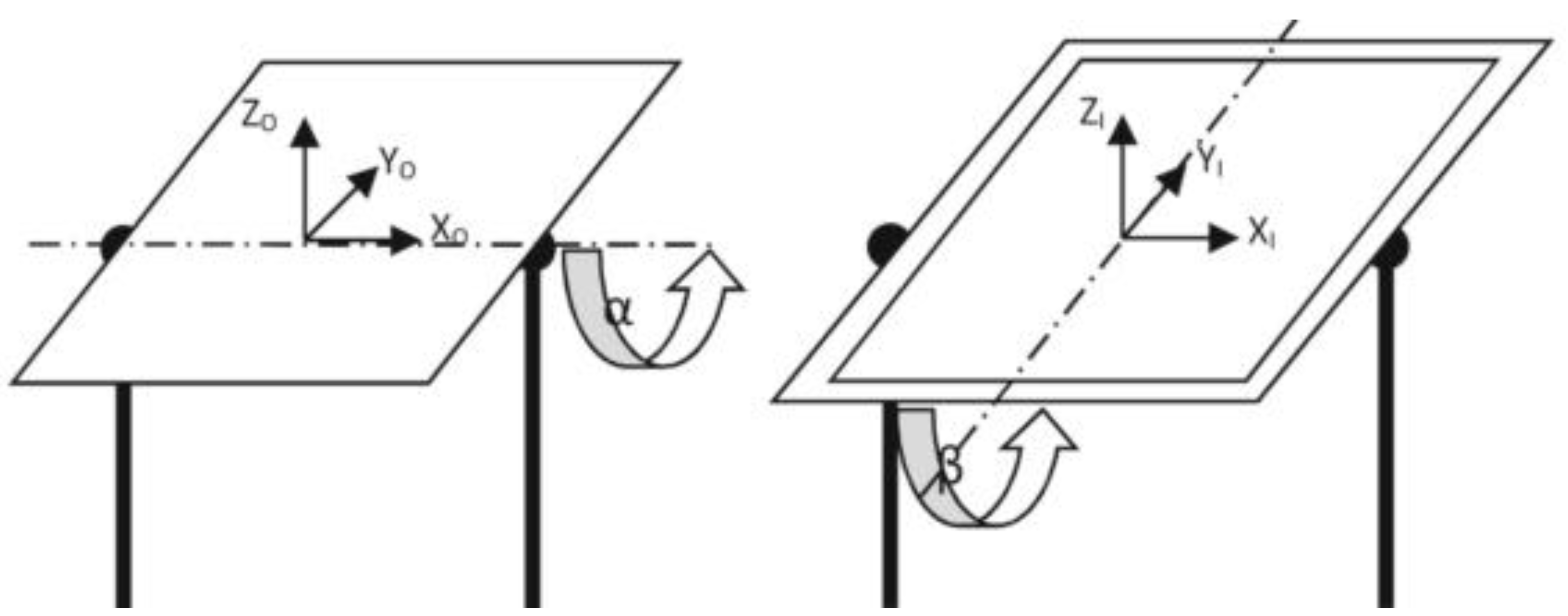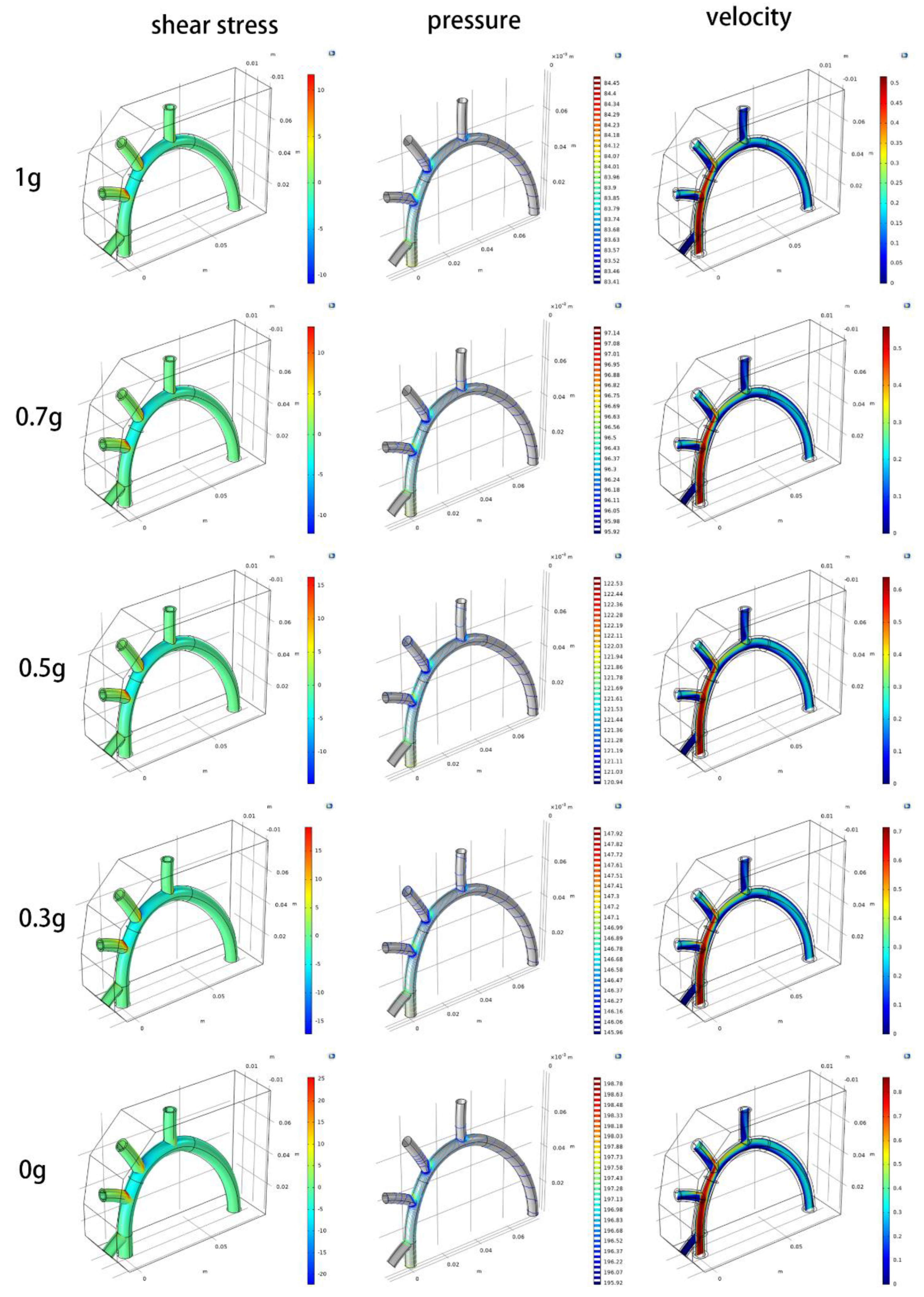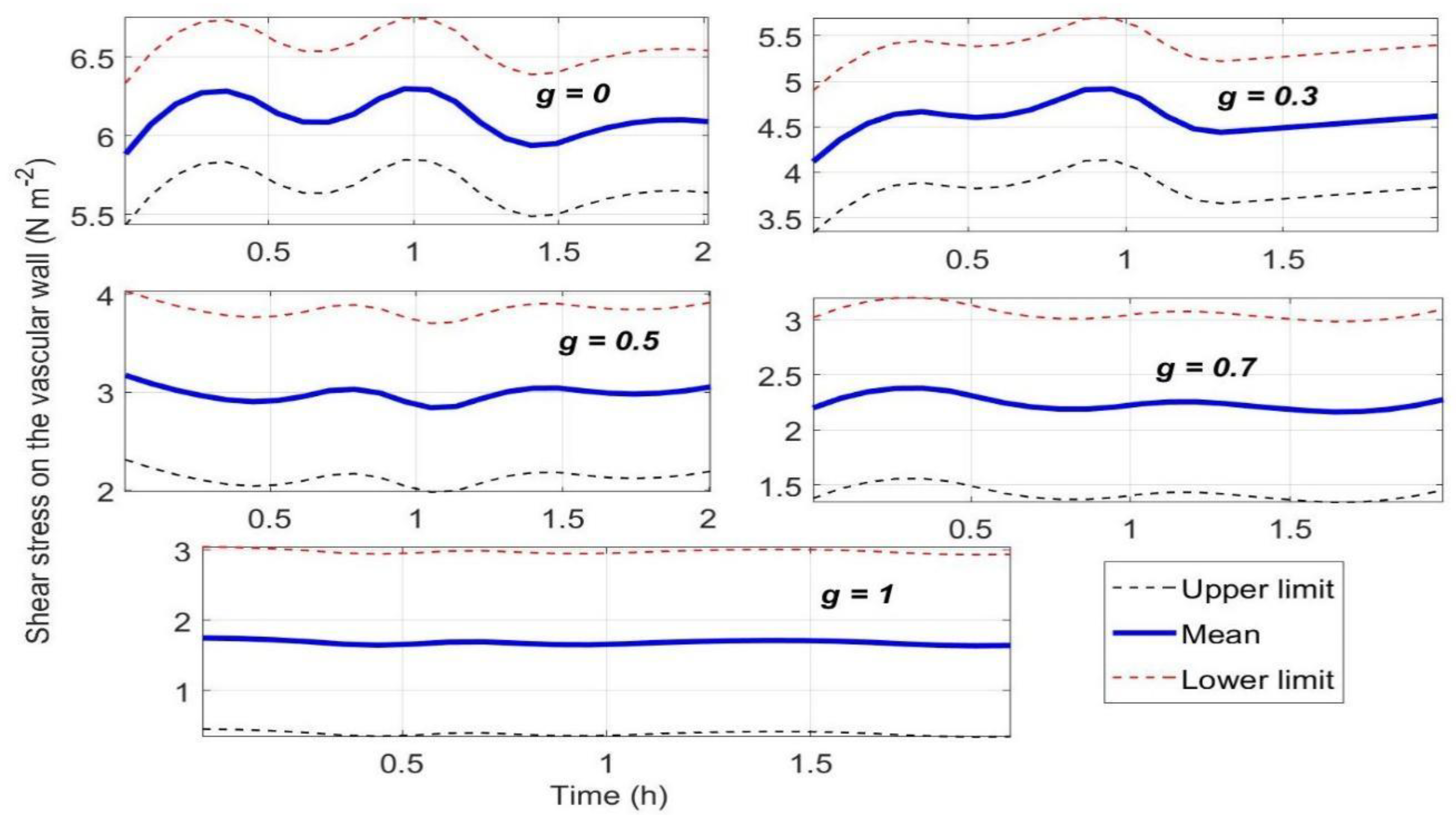Hemodynamic Characteristics of Cardiovascular System in Simulated Zero and Partial Gravities Based on CFD Modeling and Simulation
Abstract
:1. Introduction
2. Materials and Methods
2.1. Simulated Zero and Partial Gravities
2.2. CFD Modeling and Simulation of Cardiovascular System under Simulated Zero and Partial Gravities
- (1)
- The flow in the blood artery was considered to be a laminar flow, assuming that the cardiovascular system was in good health.
- (2)
- A mechanical analysis of the deformation of the tissue and artery, where it is assumed that any change in the geometric configuration is unaffected by the shape of the vessel walls and that the blood flow domain of the cardiovascular system is invariable with only a one-way weak fluid-structural coupling.
- (1)
- Laminar flow
- (2)
- Solid mechanics
3. Results and Discussion
3.1. Simulated ZPG Realized by Random Walk
3.2. CFD Modeling of Cardiovascular System
3.2.1. Geometric Configuration of Cardiovascular System
3.2.2. Boundary Conditions
3.3. Fluid-Dynamics Analyses by CFD Simulation
3.4. Discussions
4. Conclusions
Author Contributions
Funding
Institutional Review Board Statement
Informed Consent Statement
Data Availability Statement
Acknowledgments
Conflicts of Interest
References
- Braksiek, R.J.; Roberts, D.J. Amusement park injuries and deaths. Ann. Emerg. Med. 2002, 39, 65–72. [Google Scholar] [CrossRef] [PubMed]
- Smith, D.H.; Meaney, D.F. Roller coasters, g forces, and brain trauma: On the wrong track? J. Neurotrauma 2002, 19, 1117–2220. [Google Scholar] [CrossRef] [PubMed]
- Pelletier, A.R.; Gilchrist, J. Roller coaster related fatalities, United States, 1994–2004. Inj. Prev. 2005, 11, 309–312. [Google Scholar] [CrossRef]
- Wang, Y.; Yan, R.; Shi, Q.; Wang, Z.; Yuan, Y.; Cheng, H.; Li, S.; Fan, Y.; Zhuang, F.; Dai, K. Effects of microgravity and hypergravity on platelet function. Thromb. Haemost. 2009, 101, 902–910. [Google Scholar] [CrossRef]
- Nabavi, N.; Khandani, A.; Camirand, A.; Harrison, R.E. Effects of microgravity on osteoclast bone resorption and osteoblast cytoskeletal organization and adhesion. Bone 2011, 49, 965–974. [Google Scholar] [CrossRef]
- Cayce, W.R.; Zerull, R.G. Myocardial infarction occurring at the conclusion of centrifuge training in a 37-year-old aviator. Aviat Space Environ. Med. 1992, 63, 1106–1108. [Google Scholar]
- Riley, D.A.; Ellis, S.; Giometti, C.S.; Hoh, J.F.; Ilyina-Kakueva, E.I.; Oganov, V.S.; Slocum, G.R.; Bain, J.L.; Sedlak, F.R. Muscle sarcomere lesions and thrombosis after spaceflight and suspension unloading. J. Appl. Physiol. 1992, 73, 33–43. [Google Scholar] [CrossRef] [PubMed]
- Rowe, W.J. Interplanetary travel and permanent injury to normal heart. Acta Astronaut. 1997, 40, 719–722. [Google Scholar] [CrossRef]
- Rowe, W.J. The Apollo-15 Space Syndrome. Circulation 1998, 97, 119–120. [Google Scholar] [CrossRef]
- Nencini, P.; Basile, A.M.; Sarti, C.; Inzitari, D. Cerebral hemorrhage following a roller coaster ride. J. Am. Med. Assoc. 2000, 284, 832–833. [Google Scholar] [CrossRef]
- Perrier, E.; Manen, O.; Cinquetti, G. Essential thrombocytosis and myocardial infarction in an aircrew member: Aeromedical concerns. Aviat Space Environ. Med. 2006, 77, 69–72. [Google Scholar] [PubMed]
- Hoson, T.; Kamisaka, S.; Yamashita, M.; Masuda, Y. Automorphosis of higher plants on a 3-D clinostat. Adv. Space Res. Off. J. Comm. Space Research. 1998, 21, 1229–1238. [Google Scholar] [CrossRef] [PubMed]
- Hoson, T.; Kamisaka, S.; Masuda, Y.; Yamashita, M.; Buchen, B. Evaluation of the three-dimensional clinostat as a simulator of weightlessness. Planta 1997, 203, 187. [Google Scholar] [CrossRef] [PubMed]
- Micco, V.D.; Scala, M.; Aronne, G. Evaluation of the effect of clinostat rotation on pollen germination and tube development as a tool for selection of plants in Space. Acta Astronaut. 2006, 58, 464–470. [Google Scholar] [CrossRef]
- Perbal, G. Plant Development in Microgravity; Springer: New York, NY, USA, 2006; pp. 267–290. [Google Scholar]
- Wuest, S.L.; Richard, S.; Walther, I.; Furrer, R.; Anderegg, R.; Sekler, J.; Egli, M. A Novel Microgravity Simulator Applicable for Three-Dimensional Cell Culturing. Microgravity Sci. Technol. 2014, 26, 77–88. [Google Scholar] [CrossRef]
- Corydon, T.J.; Kopp, S.; Wehland, M.; Braun, M.; Schütte, A.; Mayer, T.; Hülsing, T.; Oltmann, H.; Schmitz, B.; Hemmersbach, R.; et al. Alterations of the cytoskeleton in human cells in space proved by life-cell imaging. Sci. Rep. 2016, 6, 20043. [Google Scholar] [CrossRef]
- Kim, Y.J.; Jeong, A.J.; Kim, M.; Lee, C.; Ye, S.-K.; Kim, S. Time-averaged simulated microgravity (taSMG) inhibits proliferation of lymphoma cells, L-540 and HDLM-2, using a 3D clinostat. BioMed. Eng. OnLine 2017, 16, 48. [Google Scholar] [CrossRef]
- Borst, A.G.; Van Loon, J.J.W.A. Technology and developments for the random positioning Machine, RPM. Microgravity Sci. Technol. 2008, 21, 287–292. [Google Scholar]
- Kang, C.-Y.; Zou, L.; Yuan, M.; Wang, Y.; Li, T.-Z.; Zhang, Y.; Wang, J.-F.; Li, Y.; Deng, X.-W.; Liu, C.-T. Impact of simulated microgravity on microvascular endothelial cell apoptosis. Eur. J. Appl. Physiol. 2011, 111, 2131–2138. [Google Scholar] [CrossRef]
- Gerber, B.; Singh, J.-L.; Zhang, Y.; Liou, W. A computer simulation of short-term adaptations of cardiovascular hemodynamics in microgravity. Comput. Biol. Med. 2018, 102, 86–94. [Google Scholar] [CrossRef]
- Chaichana, T.; Sun, Z.H.; Jewkes, J. Computation of hemodynamics in the left coronary artery with variable angulations.Biomechanics and Modeling in Mechanobiology. J. Biomech. 2011, 44, 1869–1878. [Google Scholar] [CrossRef] [PubMed]
- Hu, D.; Li, S.; Liu, X.; Liu, H.; Liu, G. Kinetic model derivation for design, building and operation of solid waste treatment unit based on system dynamics and computer simulation. bioRxiv 2022. bioRxiv:11.18.516877. [Google Scholar]
- Eric, K.; Jeffrey, Z.; Kalin, V.; Roy, K. Counteraction of antibiotic production and degradation stabilizes microbial communities. Nature 2015, 521, 516–534. [Google Scholar]
- Multiphysics, C.; Guide, C.M.U. Comsol. Inc. Burlington, MA, USA. 2012. Available online: www.comsol.com (accessed on 10 September 2022).
- Hu, D.; Li, L.; Liu, H.; Sun, Y. Design and control of rotating soil-like substrate plant-growing facility based on plant water requirement and computational fluid dynamics simulation. Ecol. Eng. 2014, 64, 269–275. [Google Scholar] [CrossRef]
- Mathworks, Inc. MATLAB/Statistics Toolbox. 2021. Available online: www.mathworks.com (accessed on 10 September 2022).
- Comsol, Inc. COMSOL/Computational Fluid Dynamics Module. 2021. Available online: www.comsol.com (accessed on 15 October 2022).
- Kim, T.Y. Theoretical study on microgravity and hypogravity simulated by random positioning machine. Acta Astronaut. 2020, 177, 684–696. [Google Scholar] [CrossRef]
- Asakura, T.; Karino, T. Flow patterns and spatial distribution of atherosclerotic lesions in human coronary arteries. Circ. Res. 1990, 66, 1045–1066. [Google Scholar] [CrossRef]
- Longest, P.W.; Kleinstreuer, C.; Buchanan, J.R. Efficient computation of micron-particle dynamics including wall effects. Comput. Fluids 2004, 33, 577–601. [Google Scholar] [CrossRef]
- Segadal, L.; Matre, K. Blood velocity distribution in the human ascending aorta. Circulation 1987, 76, 90–100. [Google Scholar] [CrossRef]
- Oyre, S.; Ringgaard, S.S.; Kozerke, S.S.; Paaske, W.P.; Scheidegger, M.B.; Boesiger, P.; Pedersen, E.M. Quantitation of circumferential subpixel vessel wall position and wall shear stress by multiple sectored three dimensional paraboloid modeling of velocity encoded cine, M.R. Magn Reson Med. 1998, 40, 645–655. [Google Scholar] [CrossRef]
- Irace, C.; Cortese, C.; Fiaschi, E.; Carallo, C.; Farinaro, E.; Gnasso, A. Wall shear stress is associated with intima-media thickness and carotid atherosclerosis in subjects at low coronary heart disease risk. Stroke 2004, 35, 464–468. [Google Scholar] [CrossRef] [Green Version]





| Parameter | Value | Unit | Significance |
|---|---|---|---|
| ωx | [0.25, 0.76] | Rad s−1 | Angular velocity range of x-axis |
| ωy | [0.20, 0.78] | Rad s−1 | Angular velocity range of y-axis |
| ax | 0.26 | dimensionless | Maximum number of changing in sign for ωx during 1 s |
| ay | 0.24 | dimensionless | Maximum number of changing in sign for ωy during 1 s |
| T | 2 | h | Terminal time of CFD simulation |
| ρ | 1060 | Kg m−3 | Blood density |
| μ | 5 × 10−3 | N·s m−2 | Dynamic viscosity of blood |
| ρs1 | 960 | Kg m−3 | Artery density |
| ρs2 | 1200 | Kg m−3 | Cardiac muscle density |
| T | 20 | ℃ | Temperature |
| pr | 1 | atm | Atmospheric pressure |
| μla | 6.2 × 106 | N m−2 | Lame’ parameter of artery for linear elastic behavior |
| μnla | 1.24 × 108 | N m−2 | Lame’ parameter of artery for nonlinear elastic behavior |
| μlc | 7.2 × 106 | N m−2 | Lame’ parameter of cardiac muscle for linear elastic behavior |
| μnlc | 1.44 × 108 | N m−2 | Lame’ parameter of cardiac muscle for nonlinear elastic behavior |
| Options | Value | Description |
|---|---|---|
| Number of free tetrahedral elements | 106 | To achieve higher precision and a faster rate of convergence throughout the simulation process, relatively fewer finite elements must be used. |
| Element size range of entire geometry | [4.08, 8.15] | All domains’ free triangular and tetrahedral elements come in a variety of sizes. |
| Element size range of boundary | [3.04, 1.56] | On specific borders in Figure 3, finer grids were used to obtain a more accurate answer. |
| Solver | SPOOLES | For calculations and simulations, a stationary sparse object-oriented linear equation solver was used. |
| Relative tolerance | 10−3 | Instead of doing a set number of iterations, the solver iterates until the condition given by the relevant operation feature is satisfied. |
| Nonlinear method | Automatic (Newton) | Repeat the damping-factor reduction using an affine invariant form of the damped Newton technique until the relative error is lower than it was in the previous iteration. |
| Minimum damping factor | 10−7 | For the damped Newton methodology, the damping factor’s minimum value. |
| Maximum number of iterations | 120 | The most iterations that can be performed to arrive at a distinct solution. |
| Adaptive mesh refinement | Yes | A strategy for increasing solution precision by customizing the mesh to the physical characteristics of the issue. |
| Time interval of simulation | 2 | CFD simulation lasts 2 h |
Disclaimer/Publisher’s Note: The statements, opinions and data contained in all publications are solely those of the individual author(s) and contributor(s) and not of MDPI and/or the editor(s). MDPI and/or the editor(s) disclaim responsibility for any injury to people or property resulting from any ideas, methods, instructions or products referred to in the content. |
© 2023 by the authors. Licensee MDPI, Basel, Switzerland. This article is an open access article distributed under the terms and conditions of the Creative Commons Attribution (CC BY) license (https://creativecommons.org/licenses/by/4.0/).
Share and Cite
Sun, L.; Ding, L.; Li, L.; Yin, N.; Yang, N.; Zhang, Y.; Xing, X.; Zhang, Z.; Dong, C. Hemodynamic Characteristics of Cardiovascular System in Simulated Zero and Partial Gravities Based on CFD Modeling and Simulation. Life 2023, 13, 407. https://doi.org/10.3390/life13020407
Sun L, Ding L, Li L, Yin N, Yang N, Zhang Y, Xing X, Zhang Z, Dong C. Hemodynamic Characteristics of Cardiovascular System in Simulated Zero and Partial Gravities Based on CFD Modeling and Simulation. Life. 2023; 13(2):407. https://doi.org/10.3390/life13020407
Chicago/Turabian StyleSun, Lei, Lijie Ding, Lei Li, Ningning Yin, Nianen Yang, Yi Zhang, Xiaodong Xing, Zhiyong Zhang, and Chen Dong. 2023. "Hemodynamic Characteristics of Cardiovascular System in Simulated Zero and Partial Gravities Based on CFD Modeling and Simulation" Life 13, no. 2: 407. https://doi.org/10.3390/life13020407
APA StyleSun, L., Ding, L., Li, L., Yin, N., Yang, N., Zhang, Y., Xing, X., Zhang, Z., & Dong, C. (2023). Hemodynamic Characteristics of Cardiovascular System in Simulated Zero and Partial Gravities Based on CFD Modeling and Simulation. Life, 13(2), 407. https://doi.org/10.3390/life13020407






